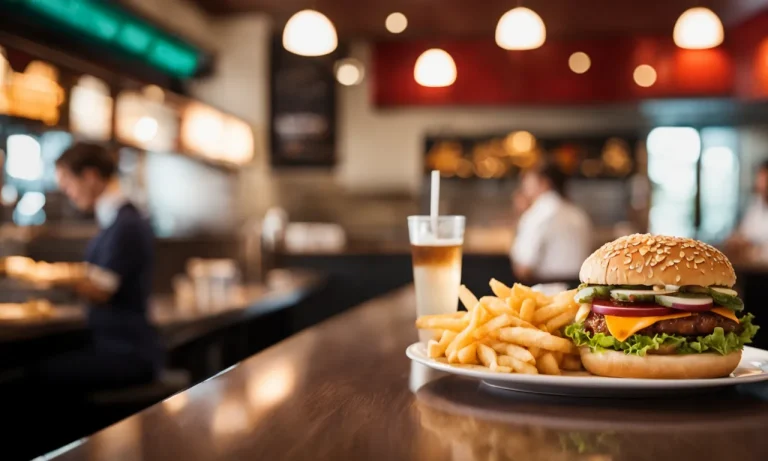Ever wondered where the concept of restaurants first began? Eating out is such a common part of life today, but restaurants as we know them are a relatively modern invention. In this comprehensive guide, we’ll take a deep dive into the history of public dining to uncover the origins of the restaurant.
If you’re short on time, here’s a quick answer to your question: The first recognizable restaurant is considered to have been opened by Boulanger in 1765 in Paris, France. However, establishments serving food to the public existed long before then.
Early Public Dining Establishments
Throughout history, people have gathered to share meals in various settings. The concept of a restaurant, as we know it today, has its roots in the early public dining establishments that emerged in different parts of the world.
These establishments provided a space for people to eat and socialize, offering a precursor to the modern dining experience. Let’s explore some of the early public dining establishments that laid the foundation for the restaurants we know today.
Inns and Taverns in Ancient Rome and Greece
In ancient Rome and Greece, inns and taverns were the primary places where people could enjoy a meal outside their homes. These establishments catered to travelers, offering food, drink, and lodging. Inns in ancient Rome, known as “cauponae,” served as a meeting place for locals and travelers alike.
They provided a variety of dishes, including soups, stews, and roasted meats. Similarly, ancient Greek taverns, known as “symposia,” were social hubs where people gathered to eat, drink, and engage in lively discussions.
These early public dining establishments laid the groundwork for the communal dining experience that restaurants would later embrace.
Teahouses in China and Japan
In China and Japan, teahouses played a significant role in the development of public dining establishments. Teahouses, or “chashitsu” in Japan and “chaguan” in China, were places where people could gather to enjoy tea and light refreshments.
These establishments became popular during the Tang Dynasty in China and the Edo period in Japan. Teahouses not only provided a space for socializing but also offered a respite from the bustling city streets.
People would gather in these serene settings to savor the flavors of tea and indulge in delicate snacks like steamed buns and rice cakes. The teahouse culture in both China and Japan influenced the concept of leisurely dining, which eventually paved the way for modern restaurants.
Coffeehouses in the Middle East
The Middle East played a crucial role in the evolution of public dining establishments with the emergence of coffeehouses. Coffeehouses, also known as “qahveh khaneh” in Persian, became popular gathering places in cities like Istanbul, Cairo, and Damascus during the Ottoman Empire.
These establishments not only served coffee but also offered a space for intellectual discussions, socializing, and entertainment. Patrons would gather in coffeehouses to enjoy a cup of coffee, play board games, listen to music, or engage in lively conversations.
The coffeehouse culture in the Middle East laid the foundation for the modern café culture we see today, where people gather to enjoy a cup of coffee and spend time in a relaxed atmosphere.
These early public dining establishments, whether in ancient Rome and Greece, China and Japan, or the Middle East, shaped the concept of communal dining and paved the way for the first restaurants. Understanding the origins of these establishments helps us appreciate the rich history and cultural significance of restaurants in our society today.
The First Restaurants Emerge in 18th Century France
When it comes to the origins of restaurants, France takes the crown. In the 18th century, Paris became the birthplace of what we now know as the modern restaurant. With its vibrant culinary scene and growing urban population, Paris was the perfect setting for the emergence of these dining establishments.
Paris Becomes a Dining Destination
During the 18th century, Paris experienced a culinary revolution. The city saw an influx of people from various social classes, including the bourgeoisie who sought to enjoy the pleasures of dining out.
Parisian culture began to embrace the idea of eating meals in public spaces, leading to the establishment of the first restaurants.
These early restaurants were often located in busy urban areas, offering a wide range of dishes to cater to different tastes. People flocked to these establishments to socialize, enjoy good food, and experience the vibrant atmosphere of Parisian dining.
The popularity of restaurants in Paris quickly spread to other major cities in France and eventually across the world. Today, French cuisine is celebrated for its rich history and influence on global gastronomy.
Boulanger Pioneers the Modern Restaurant Model
One name that stands out in the history of the first restaurants is that of Monsieur Boulanger. In the late 18th century, Boulanger opened a dining establishment in Paris called “La Grande Taverne de Londres.” This establishment is widely recognized as the first modern restaurant.
Unlike traditional eating establishments of the time, Boulanger’s restaurant offered a unique dining experience. It had an extensive menu, featuring a variety of dishes that customers could choose from. This departure from the fixed meals served at inns and taverns was groundbreaking.
Boulanger’s restaurant became a popular destination for both locals and visitors, attracting attention for its innovative approach to dining. It paved the way for the restaurant model that we still see today, where customers have the freedom to select their meals from a diverse menu.
The success of Boulanger’s restaurant inspired other entrepreneurs to follow suit, leading to the rapid growth of the restaurant industry in France and beyond.
For more information on the history of restaurants, you can visit history.com or britannica.com.
Restaurants Spread Throughout Europe and America
Restaurants have become an integral part of our modern society, offering a variety of delicious meals and dining experiences. But have you ever wondered where it all began? The history of restaurants can be traced back to Europe, where the concept of dining out first took root.
French Haute Cuisine Influences Europe
In the late 18th century, France was at the forefront of culinary innovation. French chefs, known for their mastery of flavors and presentation, created a style of cooking called “haute cuisine.” This refined and elaborate form of cooking quickly gained popularity among the European aristocracy.
As French cuisine became more influential, the demand for dining establishments that specialized in this style of cooking grew. This led to the emergence of the first restaurants in cities like Paris and Lyon.
These establishments offered a place for patrons to enjoy the finest French dishes in a comfortable setting.
One of the earliest examples of a restaurant in France is La Grande Taverne de Londres, which opened in 1782. It quickly became a gathering place for the French elite, offering an extensive menu and a sophisticated dining experience.
The success of these early French restaurants paved the way for the spread of the restaurant culture throughout Europe. Soon, other countries like Italy, Germany, and England began to adopt the concept of dining out and opened their own restaurants.
Immigrants Bring Europe’s Restaurant Culture to U.S.
In the 19th century, a wave of European immigrants arrived in the United States, bringing with them their culinary traditions and restaurant culture. Many of these immigrants were from countries like Italy, Germany, and Ireland, where restaurants had already become a popular dining option.
These immigrants played a crucial role in introducing the restaurant culture to America. They opened small eateries that served traditional dishes from their home countries, catering to a diverse range of tastes and preferences.
One notable example is the Delmonico’s restaurant, which opened in New York City in 1837. It quickly became a symbol of fine dining and introduced Americans to the concept of a restaurant as a place to enjoy a luxurious meal.
As the restaurant industry continued to grow in the United States, new culinary trends emerged, reflecting the diverse cultural influences of the immigrant population. Today, American cuisine is a fusion of various culinary traditions, thanks in part to the pioneering efforts of these early restaurateurs.
For more information on the history of restaurants and their cultural significance, you can visit History.com.
The Evolution of Restaurants in the 20th and 21st Centuries
Restaurants have come a long way since their humble beginnings. In the 20th and 21st centuries, they have seen significant changes and innovations that have transformed the dining experience. From the rise of fast food chains to the emergence of celebrity chefs and the advent of online delivery and reservations, the restaurant industry has continuously evolved to meet the changing demands and preferences of customers.
Fast Food Chains Take Over America
One of the most significant developments in the restaurant industry in the 20th century was the rise of fast food chains. In the 1950s, restaurants like McDonald’s and Burger King began to gain popularity, offering quick and affordable meals to Americans on the go.
This marked a shift in dining habits, as people started favoring convenience and speed over traditional sit-down meals. Fast food chains revolutionized the way people ate, and their success paved the way for the expansion of the industry on a global scale.
Celebrity Chefs and Foodie Culture
In recent decades, there has been a surge in interest in food and cooking, leading to the rise of celebrity chefs and the emergence of foodie culture. Celebrity chefs like Gordon Ramsay, Jamie Oliver, and Anthony Bourdain have become household names, captivating audiences with their culinary skills and charismatic personalities.
Foodie culture, with its emphasis on exploring new flavors, dining experiences, and sharing food experiences on social media, has transformed the restaurant industry. People are now more willing to try innovative and unique dishes, and restaurants have responded by offering diverse and creative menus to cater to these adventurous tastes.
The Rise of Online Delivery and Reservations
With the advent of the internet and technology, the way we order food and make reservations has changed dramatically. Online delivery platforms like Uber Eats, Grubhub, and DoorDash have revolutionized the way we get our meals.
Customers can now easily order food from their favorite restaurants and have it delivered right to their doorsteps. Similarly, online reservation platforms like OpenTable have made it convenient for diners to book tables at their preferred restaurants with just a few clicks.
These technological advancements have made dining out more accessible and convenient, further shaping the restaurant industry in the 21st century.
The evolution of restaurants in the 20th and 21st centuries has been driven by various factors, including changing consumer preferences, technological advancements, and cultural shifts. As we continue to move forward, it will be fascinating to see how restaurants further innovate and adapt to meet the ever-changing needs and desires of diners.
Conclusion
While various forms of public dining existed long before, restaurants as we know them trace their roots back to 18th century France. The opening of Boulanger’s venue in Paris set the standard for the modern restaurant experience.
From there, restaurant culture gradually spread throughout Europe and then made its way over to America. Today, restaurants remain a central part of our lives, though the industry continues to evolve with new technology and dining trends.






